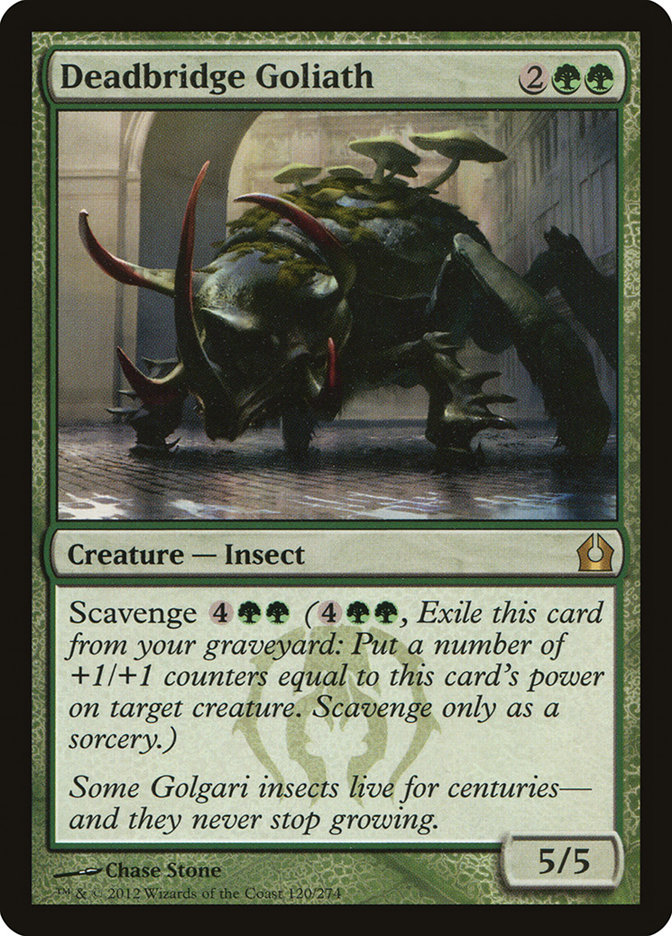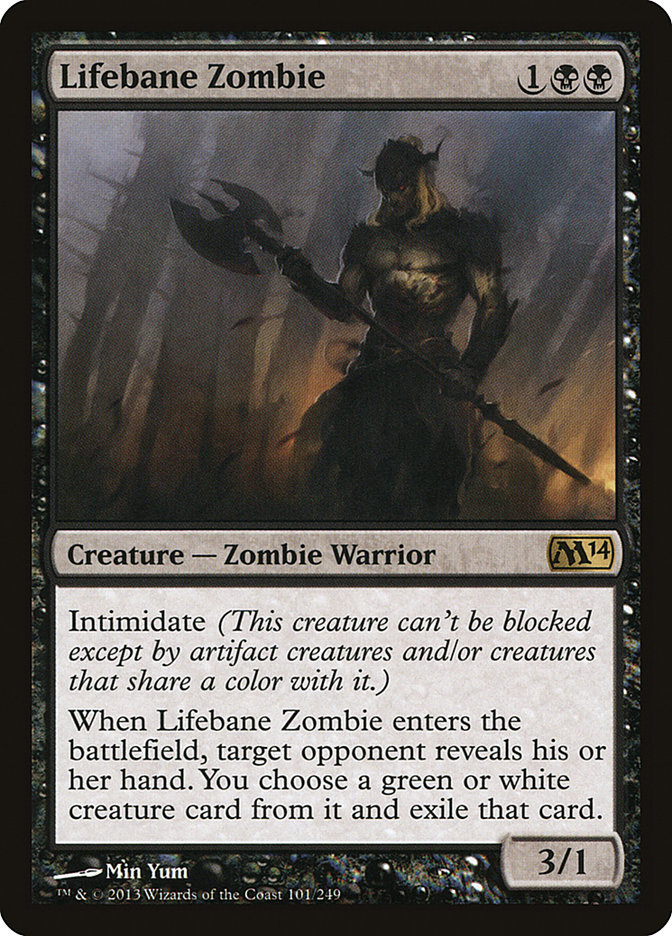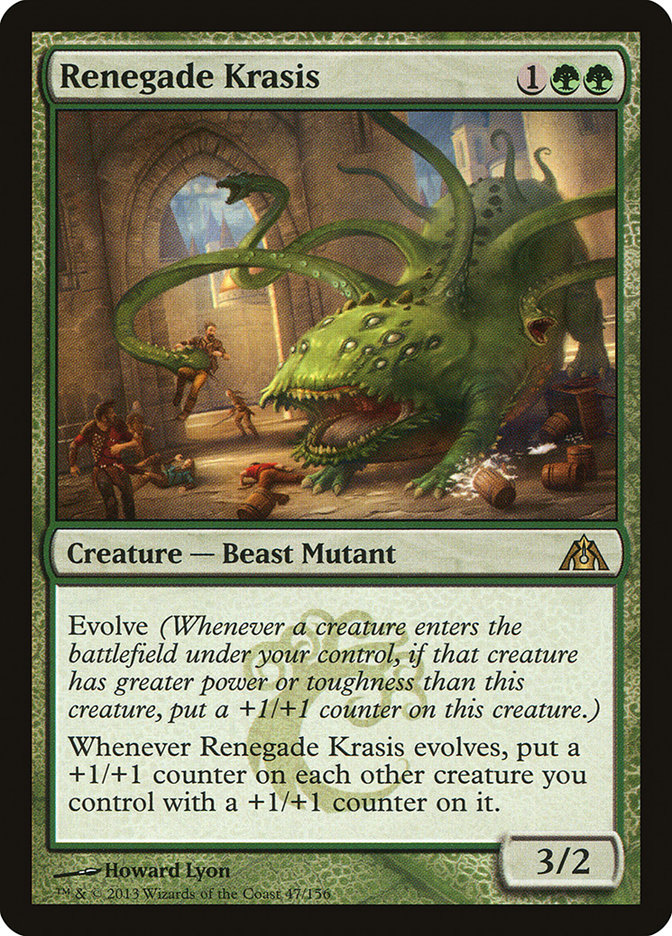Remember when Magic used to be about cards Andrew Cuneo plays?
When did it become about cards that Brian Kibler plays?
Magic used to be a lot more about resource management, incremental advantage, making an exploitive deck with an unbeatable endgame or combo, and so on. Nowadays, there is a much larger focus on creatures being the primary resource rather than mana or cards in hand (which is generally more fun for most people).
Sometimes I see people compare Standard Magic formats of today with those of years gone by. They are different animals, to be sure, even though the underlying core game engine is the same. But which is better?
They are different.
I’d like to talk general game design, including why Vintage Magic is to Standard Magic what DotA is to League of Legends. First, however, I’d like to talk a bit about the Theros card inspiring this discussion, a card that is the exact kind of card Kibler would play:
Polukranos, World-Eater 2GG
Legendary Creature – Hydra
XXG: Monstrosity X (If this creature isn’t monstrous, put X +1/+1 counters on it and it becomes monstrous)
When Polukranos, World-Eater becomes monstrous, it deals X damage divided as you choose among any number of target creatures your opponents control. Each of those creatures deals damage equal to its power to Polukranos.
5/5
Evaluating Polukranos is particularly interesting because we still don’t fully know what the keyword monstrosity does. As far as I can glean from text, Monstrosity is preceded by an activation cost and contains a number that indicates how many +1/+1 counters the creature gets when you use its ability, which can only be used once.
That Polukranos has a "becomes monstrous" ability is probably not the universal standard, although it is surely not the only one. Polukranos’ X is also surely not the standard. Curiously, while monstrosity looks like an ability word on Polukranos, given his second ability it really is a pretty simple keyword when we look at a hypothetical monstrous card:
Grizzly Monstrosity 1G
Creature – Horror Bear
3G: Monstrosity 2 (If this creature isn’t monstrous, put two +1/+1 counters on it and it becomes monstrous)
2/2
Looking at the simple version, it’s pretty clear that the standard Monstrosity creature involves paying for a body with the option to later upgrade it. Alright, we can work with that. Keep in mind that this is generally a lot better than echo. Not only do you not need to commit to paying the second half on the following turn, but you don’t have to commit during your upkeep (instead being able to choose to pump your creature in combat or not pump it at all depending on how your opponent attacks or blocks). Echo’s only real advantage is that your creature is bigger for blocking with (or attacking with if it has Haste) for one turn since monstrosity only gives you part of the body up front.
Monstrosity is also similar to the levelers from Rise of the Eldrazi. The differences? Levelers generally elevated incrementally, even eventually entering level three. However, leveling had to take place as a sorcery. Just being at instant speed radically changes the nature of the ability.
So how about our good friend Polukranos?
Well, the body you start with is a 5/5 for 2GG. That is already a pretty solid rate, meaning we really don’t need to get all that much textbox to get excited about the card. However, we do need to get something. Deadbridge Goliath is a 5/5 for 2GG with scavenge 4GG and is basically the definition of "fringe playable" in Standard.
How does Polukranos compare to Deadbridge Goliath? Both start with the same body for the same cost, with an ability that is sort of like a second spell that can be used once (sort of like Flashback). Polukranos has the advantages of being able to be used before it dies (whenever you want, if you can afford it) and being activated at instant speed. Deadbridge Goliath’s ability can’t be used immediately, but it does have the advantage of working when it dies or ends up in the graveyard by any other means. Overall, the timing of "while alive" or "while dead" is pretty close to a wash. That Polukranos can be used at instant speed is an advantage, but one that is more properly considered part of the bonus spell we are getting.
Now let’s compare the bonus spell attached to both.
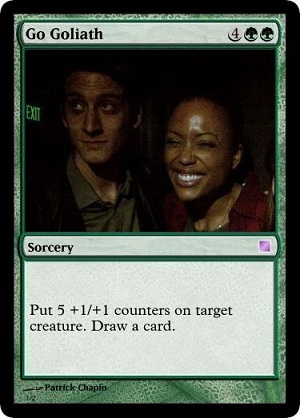
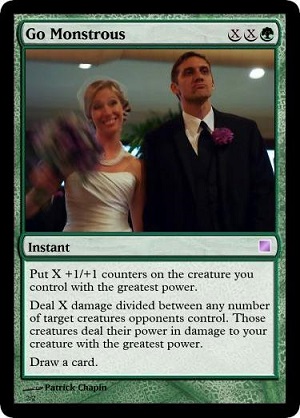
Why include draw a card on each? Because neither ability costs you a card.
Would I play Go Goliath in Constructed? Not likely, but it would be a great Limited card. This is not an indictment of Deadbridge Goliath; it just means Deadbridge Goliath is not as strong as a 5/5 for 2GG that draws a card when it dies.
While this makes it easier to evaluate Deadbridge Goliath’s ability, Polukranos’ ability is not quite as simple. We are even taking some liberties to try to capture the fact that his +1/+1 counters go on him and not just anyone (like the Goliath). That it is a (double) X spell with multiple outputs further muddies the waters.
Would I pay three mana to deal one damage to a creature, put a +1/+1 counter on my biggest creature, and draw a card? I could see playing that card, but it isn’t incredible.
Would I pay five mana to deal two damage divided however I want, put two +1/+1 counters on my largest creature, and draw a card? Maybe, but what really makes it appealing is that doesn’t just sit in in my hand like a situation cantrip would. It is actually sitting on a 5/5 creature putting in work.
Go Monstrous is probably closer to a card I would actually play in Constructed, particularly if people end up playing a reasonable number of one- and two-toughness creatures. It is particularly valuable since green doesn’t really get a lot of Arc Lightnings, let alone one at such a halfway reasonable rate. Honestly, I wouldn’t play Go Goliath if it cost five. Overall, Go Monstrous is closer to a tournament-worthy rate, making Polukranos pretty close to a 2GG 5/5 that draws a quality card if you untap with it (or just have a lot of mana).
That is incredible.
Think about the natural sequence.
Turn 3: 5/5 (since we are clever and used an accelerator).
Turn 4: Fire (dealing two damage despite being a Green deck), but now we have a 7/7 already attacking.
That is a pretty filthy sequence and doesn’t involve any combos or unusual circumstances. It requires just one card. We spent four mana, then five mana, and got a 7/7 and likely killed one of our opponent’s creatures while using just a single card. That is pretty amazing.
And that is just the most basic use.
Obviously, the more mana we have, the more we can sink into Polukranos to make him even larger and deal even more damage, but what’s deceptively strong is that the threat of his ability doesn’t actually require you to use it. If your opponent doesn’t give you a juicy target and you have better things to do, you can just do them and build up your mana, threatening to eventually go even more monstrous.
Another possibility is use Polukranos as an actual 187 ability. This becomes a little more relevant when it’s super late game if we are sitting around with seven, nine, or more mana. Of course, Arc Lightning isn’t as good as it used to be, if only because creatures are slightly larger.
While there is some amount of pressure on us to activate Polukranos’ ability the turn after we play him (to get as much damage in as possible), we can also just have him sitting in play, an implied threat that makes combat an absolute nightmare for opponents.
Of course, the bigger you pump your Polukranos, the greater the risk that your opponent finds a way to finish him off with damage. A single Giant Growth could be devastating.
So how good is Polukranos?
Very good.
The first card that comes to mind power level-wise is Thundermaw Hellkite. This is a top tier Constructed card, and I have a feeling we’re going to be seeing a lot more of it over the next two years (particularly from gentlemen such as Brian Kibler, who forge decks full of fatties).
I could actually see Polukranos being so good that it puts some amount of pressure on people to play less one-toughness creatures than they otherwise would. However, it does have a pretty big drawback (outside of dying to Doom Blade).
Lifebane Zombie is already a helluva card, and it absolutely tears Polukranos to shreds. Kibler recently turned the format on its ear by cutting all of the big green creatures from his Dragonmaster G/R deck, replacing them with Hellriders and Thundermaw Hellkites. Is it really worth increasing our exposure to Lifebane Zombie?
It is at this point, we should remind ourselves that Hellrider and Thundermaw Hellkite are both rotating out. Of course, Polukranos is a very midrangey card, while Dragonmaster R/G is a much faster aggressive deck. Still, while it may not be at its best here, the card is just so sick that you can slide it into just about anything.
Polukranos also has the drawback of being legendary, but the new legend rules are favorable towards it. Whereas before playing a second copy would doom both, you can now play a second copy and sacrifice the first, letting you basically become "un-monstrous" for those games where you need to remove more small creatures.
How about an example of a possible home for Polukranos?
G/B Corpsejack by Patrick Chapin
4 Elvish Mystic
4 Arbor Elf
4 Lotleth Troll
4 Scavenging Ooze
4 Dreg Mangler
1 Varolz, the Scar-Striped
4 Corpsejack Menace
4 Polukranos, World-Eater
4 Kalonian Hydra
2 Doom Blade
2 Putrefy
4 Overgrown Tomb
3 Golgari Guildgate
10 Forest
6 Swamp
Sideboard:
4 Lifebane Zombie
3 Duress
3 Golgari Charm
1 Ratchet Bomb
1 Garruk, Caller of Beasts
1 Vraska the Unseen
1 Abrupt Decay
1 Doom Blade
This list is built using only cards from M14 and Return to Ravnica block (along with Polukranos, himself) in preparation for rotation. That means it is quite likely that Theros contains a number of improvements, such as another dual land and possibly another three-drop we actually want.
While it looks sort of like a Corpsejack Menace deck, really it is just a bunch of monsters in a good curve supported by a couple spot removal spells. Scavenging Ooze, Lotleth Troll, Dreg Mengler, Varolz, Polukranos, and Kalonian Hydra all have +1/+1 counters, so Corpsejack Menace and Kalonian Hydra both double counters can actually lead to some pretty big boards.
I have not included any Experiment Ones; however, they could work well enough to warrant replacing some number of Arbor Elfs (and possibly going up to ten one-drops). I have never really been the biggest Renegade Krasis fan, but it might actually be ok here as well if we are feeling adventurous.
Of course, we could also splash a third color depending on what mana fixing is available in Theros. Borderland Ranger is also an option to keep in mind, and honestly even Farseek is on the table.
The most likely third color is surely red for Exava. She’s not a bad fighter on her own, and if you ever pull off the Kalonian Hydra combo, it’s pretty devastating. Blue is also an option because of Vorel of the Hull Clade. With this many +1/+1 counter cards, we could get some serious mileage out of another doubler.
What else can we do with Polukranos? One aspect of the card that jumps out to me is how much of a pinger it is, which always suggests to me to check if there are any deathtouch combos we can use. Nightshade Peddler is rotating out, but if it were still legal, we could soulbond it to Polukranos and basically just Plague Wind our opponents. Basically, for every two mana we pay, we can kill another creature (and grow our legendary Hydra). All we have to be careful about is that Polukranos grows big enough to live (although even this is negotiable depending on the board).
Ready // Willing isn’t a bad card, but it’s a pretty expensive way to gain deathtouch, making the combo a lot less appealing.
Vial of Poison is a much more palatable expenditure of mana, but it’s such a weak card that we have to be able to do better.
Wasteland Viper is the best way to give deathtouch in Standard, and I think could actually make a pretty big splash. You can only use it when attacking, but this still works perfect with Polukranos. Attack with six mana and you can make Polukranos a 8/9 for the turn and kill two creatures of your choice.
Wasteland Viper also combos quite well with Kalonian Hydra. When you combine deathtouch and trample, it takes just one damage to kill each blocker, with all of the rest trampling over. This makes it all but guaranteed that two swings from a Kalonian Hydra is fatal. Lotleth Troll also has trample, so the combo works there too.
Another fun combo with Wasteland Viper is Scavenging Ooze. You can attack with an Ooze while there are no creatures in graveyards. Then when your opponent blocks, not only does the Viper give it +1/+2, but you can instant speed exile the Viper to get your Ooze up to a 4/5.
Something I find pretty interesting about Polukranos is its place in Duel Decks: Heroes vs. Monsters. If not for this, I would have guessed that Polukranos would be a $25 card or more. However, since we can buy Duel Decks for $19.99 (assuming they continue to go for retail, which is certainly not guaranteed), Polukranos’ ceiling is probably less than that.
Ok, so what does this have to do with DotA and League of Legends?
To begin with, people have a tendency to believe whatever they are good at is more skill testing and "better." People that were good at Magic in the old days see the skills that were heavily rewarded then but are less valued now. This can make it very tempting to chalk today’s Magic up as "dumbed down."
- Magic used to have crazy rules changers like Winter Orb and Stasis.
- You could use broken card drawers like Necropotence and Land Tax, yet the formats still worked; there was still a balance.
- You could craft degenerate game plans that unprepared opponents could never beat, but there were counters to everything, so if you were the best-prepared player, you could always be one step ahead.
- Going back even further, when playing Vintage, it is not uncommon to play ten or more spells in a single turn, each with countless ways to use it and a heavy reliance on proper sequencing. That’s obviously way more skill testing than just playing one or two cards a turn, right?
- Vintage cards have higher highs in power level! Playing with more powerful cards is better than playing with weak ones!
I love Vintage, I really do. It’s existence is a beautiful, terrific thing. That said, we have all heard Vintage players talk about their format compared to Standard.
"Vintage is more skill testing than Standard. You have to make more decisions, there are more lines of play, more places you can make mistakes, you get mana screwed a lot less, and more games are decided by the decisions of the pilots, plus a good Vintage deck can beat a bad one every time."
I have been there. I have said all of those same things back in the day. It wasn’t until I got involved in professional game design over a decade ago that I began to realize Vintage just puts the skill and the variance in different places than Standard.
- You don’t get mana screwed as much in Vintage as in Standard, but matchups can be even more lopsided and drawing a good mix of cards can be totally unbeatable.
- Planeswalkers are like artifacts and enchantments but with a lot more counterplay and more decisions on both sides of the table.
- Creatures as the key resource instead of mana or cards is potentially even more skill testing than mana or cards, as creatures are inherently more complicated and versatile than "draw a card" or "add one mana to your mana pool."
- There are a lot less unbeatable decks / matchups in Standard, but that shifts more of the skill into the game itself. Basically, there are less matches that are over before they begin, meaning more room for the better player to actually outplay their opponent.
- Playing ten cards in a single turn can look impressive, but once you do the dance a few times, it is really little more than tapping the correct mana for your card (which is hardly a great feat). Games of Vintage can be compressed into a much smaller number of turns at times, but this is not inherently "better."
Actually, the relationship between Vintage and Standard is basically the exact same as the relationship between DotA and League of Legends.
DotA is a custom game mode and map for Warcraft 3 created by fans a decade ago in which two teams of five fight to take towers and eventually conquer the map. While DotA just uses the Warcraft game engine and was never released professionally, DotA 2 actually just came out and is basically just a cleaned up and polished DotA, this time by a major game studio.
League of Legends is a similar style of game and has been around half as long. Just as Standard has shifted the focus away from denial, noncreature resource management, and bizarre unintuitive angles of attack, so too has League of Legends shifted what elements are important compared to DotA.
- In DotA, you can kill your own minions, denying opponents gold for killing them. Some characters have abilities that reduce your opponent’s mana. League of Legends does not remove the ability find ways to deny opponents, but there are fewer Winter Orbs, fewer Mana Drains, and fewer Strip Mines.
- In DotA, Heroes can have extremely bizarre and dramatic abilities that fundamentally change the rules of the game. In League of Legends, there are still characters that change the rules of the game, but the game is mostly about combat, teamwork, planning, and reacting to opponent’s plans. Tactics are more valued, whereas in DotA a good strategy may be nearly unbeatable before the game even begins depending on what heroes were picked and banned.
- Both games feature a map with three "lanes," which are the primary location of activity on the map. In League of Legends, incentives exist for both teams to have most of their players "laning" for a while and in a somewhat more structured set of battles. In contrast, the laning phase in DotA tends to be more chaotic and accelerated (despite DotA games often taking slightly more time than LoL games, amusingly similar to how Vintage games go to time more often than Standard games despite having less turns played).
- If someone is new to DotA, their chances against someone with some experience are basically zero, while League of Legends doesn’t have quite as inaccessible of a bar, similar to how a new player to Vintage will get rolled by a real Vintage deck and pilot whereas someone new to Standard might actually be able to play a game.
- DotA has more "crazy combos," that take advantage of two or more heroes that can work together to create effects much stronger than the sum of their parts. League of Legends also has a lot of synergies, but these tend to be much more like Voice of Resurgence + Rootborn Defenses as opposed to DotA’s Time Vault + Voltaic Key.
- Similarly, DotA has more Yawgmoth’s Wills, more Time Walks, and more Ancestral Recalls. League of Legends is more about Baneslayer Angels; Doom Blades; and Garruk, Primal Hunters. What is "power?" It’s all relative.
- Falling behind in DotA can be absolutely crippling. Losing gold when you die and other such rules can be very punishing (which some players interpret as a sign that DotA is more skill testing). In contrast, League of Legends keeps games closer more often for longer.
- League of Legends is played by significantly more players than DotA or DotA 2, just as Standard is played by significantly more players than Vintage.
- While there are many players that play both games, many DotA players believe their game to be the more skill-testing game for all of the reasons listed above. However, the best players consistently win at both games, but one (LoL) has a player pool many times larger.
Magic has changed what is important over the years, and while there are always going to be some people suggesting Magic has been "dumbed down," have you ever noticed just how often the best players win these days? There is a much higher baseline for skill as a result of websites like StarCityGames.com and the existence of Magic Online, but despite this the best players win at clips that seem super human.
The thing is that many times more people play today than did years ago. The pool is much larger, and this raises the level of competition. Part of why the pool has grown so much is that the things Standard is about are more fun to more people. Vintage is still a totally awesome format, but it’s also a totally different one. Each has its place.
I happen to enjoy the old-school Magic a great deal and WotC plants just enough seeds to keep hooking me, but even someone as hardcore as me has had to make the decision "embrace the new world or die."
Polukranos?
Magic is about creatures and planeswalkers these days, and in a world like that creatures like Polukranos are going to be quite strong.
Patrick Chapin
"The Innovator"

